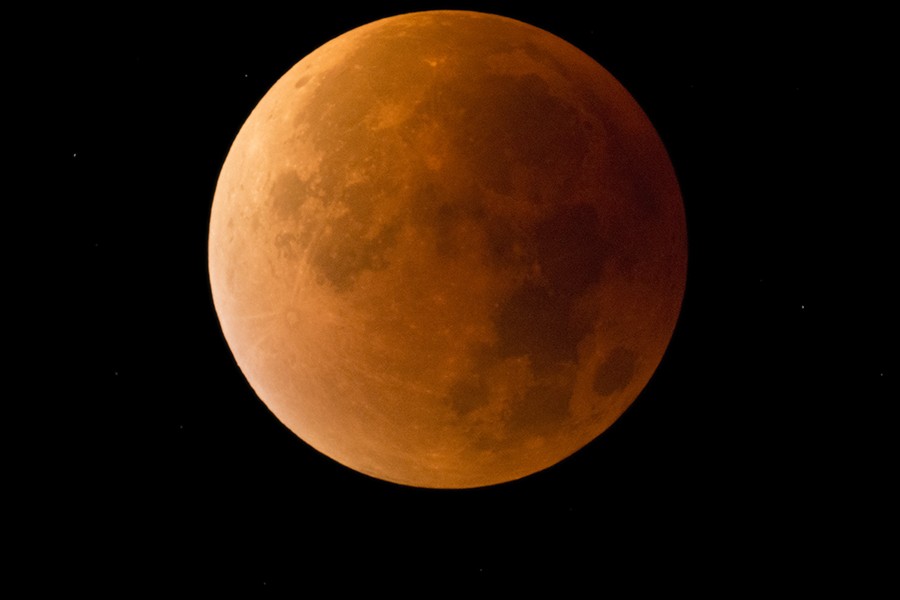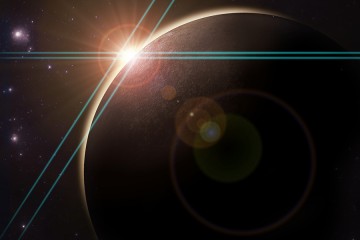Wednesday morning, if the sky is clear, we'll witness the convergence of three lunar phenomena that only occurs once every 37 years, and has probably the coolest name of all time: The super blue blood moon.
Insert shredding guitar riff here.
Here at The Hub, we could hardly contain our excitement about this lunar event, so we reached out to someone we knew would be as psyched as we are: Kirsten Hall, a fourth-year doctoral student and the Space Fellow at the Space@Hopkins initiative.
Here's her take on the super blue blood moon and what it means for us earthlings.
What is a super blue blood moon?
It's just sort of a circumstantial thing, in terms of astronomical phenomena, but still, there's some air of magic to it and the fact that these events are all occurring at the same time.
First, a blue moon is what we call the incidence of two full moons occurring in one calendar month.
Now, the moon doesn't stay the same distance from the Earth during its orbit. A super moon, which we experienced on the first of the month as well, is when the moon is in its closest approach to Earth along its orbit. It makes the moon appear, in terms of brightness and size, a lot larger in the sky. It's a pretty noticeable difference, and makes for a beautiful full moon.
And on top of that, there is a total lunar eclipse that's happening, what we call a blood moon. During this eclipse, what's happening is the Earth is moving directly in between the sun and the moon, and the moon will start looking dimmer and dimmer. But then you reach this point where the Earth is mostly in front of the sun and the sunlight gets refracted around the Earth's atmosphere, and it's sort of like a sunset.
When this happens, blue light scatters away in the Earth's atmosphere, and red light scatters along our path of vision, so the light we see appears red. If you can imagine standing on the moon and looking back on the Earth, it would look like the Earth was surrounded by sunsets—all the sunrises and sunsets happening all over the Earth all at once.
What that means to us is that all that red light goes to the moon and reflects back to us, so we see this beautiful red glow. It's just really awesome that it's happening during the super moon, because it means that it'll be that much more impressive.
Will we be able to see it in Baltimore?
The full path of totality for this particular lunar eclipse is along southeast Asia and across the western U.S. and parts of Canada. In Baltimore, we're not in the path of totality but we will see a partial lunar eclipse. If you were going to try to look at it, the best time to see it would be at about 5 a.m. EST Wednesday.
What do events like this mean to people in your profession? Doesn't a super blue blood moon pale in comparison to some of the stuff you research?
Well yeah, but it's an excellent opportunity to talk about space! It's a chance to educate people and get them excited and asking questions. I mean, we are living on this celestial object, and we are a very real part of the universe as a whole. It's so easy to forget that down here on Earth. I see it as an opportunity to remind people to look up at the sky and acknowledge that you're a part of it all.
What else is Space@Hopkins up to these days?
Now through May, we'll be accepting applications to our seed grant program. These are grants of up to $25,000 for faculty and staff from across Johns Hopkins who are involved in space-related research. These can include any number of subjects and fields including robotics, health, planetary sciences, solar physics, engineering, or astrophysics, to name a few.
One of the only requirements is that the proposals include an undergraduate researcher, which is another part of this program that is so cool and so important. It's great to include young people in STEM and space science research and to give them opportunities to get involved.
The vision that Space@Hopkins founder Chuck Bennett had was an opportunity to create more collaboration. Big ideas and big projects get carried out when you have a diverse set of minds thinking about the problem from different angles.
Clarification: An earlier version of this article misstated the optimal viewing time of the lunar eclipse
Posted in Science+Technology










